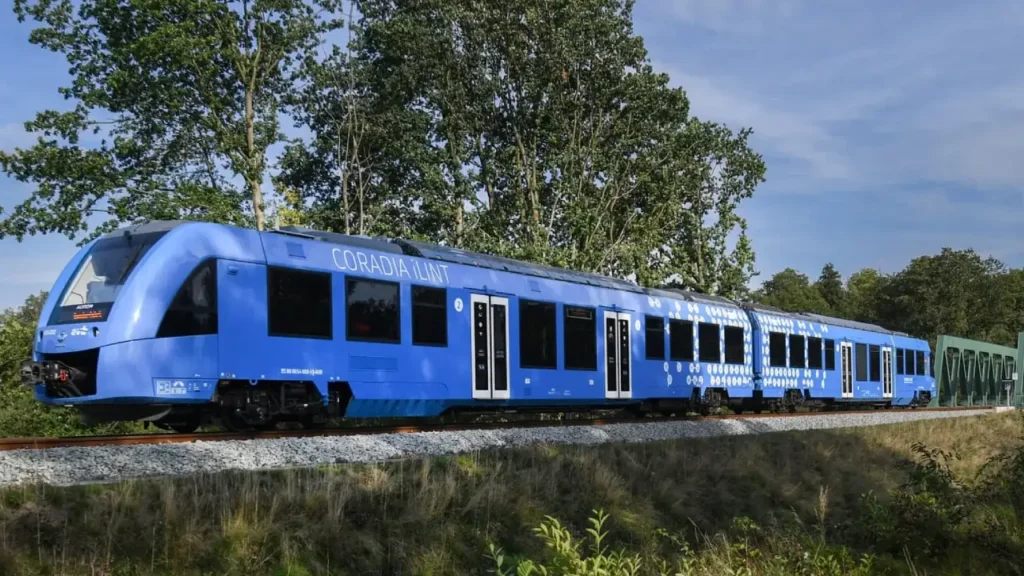India’s hydrogen train is a big step toward eco-friendly transportation. This new idea, which was tested at the Integral Coach Factory (ICF) in Chennai, offers a strong alternative to diesel-powered trains with no emissions and the most horsepower ever recorded.

We explain what makes this hydrogen train so important, how it works, and why it will change the game for India and the global green tech movement in this blog.
What Is India’s Hydrogen Train and Why It Matters
India’s first hydrogen-powered Driving Power Car isn’t just a test model; it’s a dramatic statement about climate change on rails. Fuel cells that turn hydrogen and oxygen into electricity power hydrogen trains. It doesn’t pollute the air at all because it simply gives off water vapor.
Ashwini Vaishnaw, the Minister of Railways, dubbed it a “milestone for a future-ready and sustainable India.” India is now a leader in hydrogen rail innovation, along with Germany and China, after successful experiments on July 25, 2025.
How It Works — The Tech Behind the Train
Hydrogen fuel cells work like mini power plants
- Hydrogen gas is stored in special tanks
- It’s mixed with oxygen in the fuel cell
- This chemical reaction creates electricity
- Electricity powers the motor, and the only by-product is clean water vapour
It works like an electric train, but instead of plugging into a wire, it makes its own electricity on board with hydrogen.

Record-Breaking Specs and Engineering
India didn’t just make a hydrogen train; it made the strongest one in the world. This is how it compares
| Feature | India’s Hydrogen Train | Global Standard |
|---|---|---|
| Engine Power | 1,200 HP | 500–600 HP |
| Top Speed | 110 km/h | Comparable |
| Passenger Capacity | 2,638 | ~300–500 |
| Coach Config | 10 coaches planned | Typically 5 |
| By-Product | Water Vapour | Water Vapour |
The train currently has 3 coaches: 1 passenger coach and 2 hydrogen storage units. An 8-coach version is in the works, which will become the world’s longest hydrogen-powered passenger train once deployed.
Benefits That Go Beyond the Rails
Why should you care about a hydrogen train? Because it’s not just about trains.
Cleaner Air
Eliminates diesel soot and emissions in populated areas
Make in India Power
Fully designed and built domestically — shows strong R&D potential
Net-Zero Goals
Aligned with India’s commitment to achieve net-zero railway emissions by 2030 and national carbon neutrality by 2070
Scalable Tech
Fuel cell systems used here could spin off into trucks, buses, or even boats
Real-World Use and Routes
The Jind–Sonipat segment in Haryana is the first operational route, and pilot testing is still underway on there.
The Kalka–Shimla heritage route was originally planned to open, but it is now going through technical evaluations because of the high altitudes and steep slopes.
A trial project worth ₹111.83 crore is converting a diesel-electric train with hydrogen technology so that it may be used right now.
Investment, Scale, and Long-Term Vision
This initiative is backed by serious funding
- ₹2,800 crore ($337M) for 35 hydrogen-powered trains
- ₹600 crore for hydrogen fuelling and safety infrastructure
- ₹70 crore per route for deployment
- ₹80 crore to build one train
India’s Railway Ministry is also investing in Hydrogen for Heritage, a focused program to preserve cultural routes using clean energy.
Hydrogen Trains vs Diesel Trains Quick Comparison
| Feature | Hydrogen Train | Diesel Train |
|---|---|---|
| Emissions | Zero (water only) | High (CO₂, NOx, PM) |
| Noise | Low | High |
| Fuel Type | Hydrogen | Diesel |
| Long-Term Cost | Drops over time | Rising |
| Environmental Impact | Clean | Polluting |
Conclusion
India’s hydrogen-powered train is more than just a better way to get about; it’s a big step forward for clean transportation. It puts India at the forefront of green railway technology because it has no emissions, record-breaking power, and a platform that can be expanded.
Would you take a train that runs on hydrogen every day? Tell us, since the future is slowly coming in.







